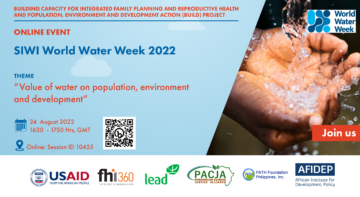News

Senior representatives of four of Africa’s Regional Economic Communities pledged to contribute to efforts to reduce the unacceptably high maternal mortality rates in their regions.
They made the pledge at a high-level advocacy workshop organized by the International Planned Parenthood Federation Africa Regional Office (IPPFAR) from August 31 to September 2, 2011 in Nairobi, Kenya.
This workshop, entitled “Multi-stakeholder policy dialogue on SRHR in Africa: Towards the ICPD +20 review and the post MDG’s agenda setting“, provided a platform for deliberation of findings from a study conducted by AFIDEP in partnership with IPPFAR.
The representatives were drawn from the Economic Community of Central African States (ECCAS), East African Community (EAC), Economic Community of West African States (ECOWAS), and the Southern Africa Development Community (SADC).
The meeting also included representatives of the African Union, UNFPA, UNDP, WHO, and other regional and national institutions working on reproductive health issues in Africa.
What the evidence showed
The study examined progress towards attainment of MDGs 5a (reduction of maternal mortality) and 5b (universal access to reproductive health services, including family planning (FP)), and drew policy and program lessons from countries that made the most progress on these MDGs.
Maternal deaths remain worryingly high
Sub-Saharan Africa (SSA) is the worst performer on MDG 5A on maternal health, accounting for about 60% of all maternal deaths globally, and with most of the countries falling far short of the MDG target to reduce Maternal Mortality Ratios (MMRs) by 75% between 1990 and 2015.
Progress in reducing maternal deaths has been insufficient, slow, and varied across regions and countries. A key positive to take from the trends is that all regions made greater progress in reducing MMRs during the 2000s compared to the 1990s.
This, together with the lessons that are propelling progress in a few countries, show that the continent can move closer to the MDG 5b target by 2015 if countries reinforce political will, technical capacity, and financial resources to accelerate the implementation of proven and affordable interventions on safe motherhood.
The median MMR for Sub-Saharan Africa declined from 780 to 530 between 1990 and 2008, representing an overall decline of 32%. Southern Africa, which has the lowest MMR of the four SSA regions, recorded an increase in MMR from 380 to 455 over the period due to the impact of HIV-AIDS. MMRs for the other three regions in 2008 were 600 in Central Africa, 569 in West Africa, and 535 in East Africa.
The overall rates of decline in MMR between 1990 and 2008 were 41% in East Africa and 29% in both West and Central Africa.
Only two countries, Equatorial Guinea and Eritrea, were on track to achieve MDG 5a by 2015, after registering overall declines of 72% and 70%, respectively, between 1990 and 2008. Other countries that made good progress and likely to attain the MDG if they reinforce their efforts include Mauritius, Cape Verde, Ethiopia, and Rwanda.
Little progress is being made in scaling up safe motherhood interventions
WHO estimates that almost three-quarters of maternal deaths can be eliminated by increasing women’s access to comprehensive reproductive health services, including FP, antenatal care, skilled attendance at birth, emergency obstetric care (including post-abortion care), maternal nutrition and postpartum care for mothers. However, the region has made dismal progress in increasing access to these life-saving maternal health services.
The vast majority of women in SSA make at least one antenatal care (ANC) visit during pregnancy. The median percentage of women attending at least one antenatal visit in SSA increased from 79% in 1993 to 86% in 2006. The latest median levels for the four sub-regions were 82% in Central Africa, 84% in West Africa, and 92% in both East and Southern Africa.
However, only about half (49%) of all pregnant women made at least 4 ANC visits in SSA around 2006, and there was little improvement from the 1993 value (45%). The latest levels of 4 ANC visits for the four regions varied widely: 39% in East Africa, 49% in West Africa, 54% in Central Africa, and 70% in Southern Africa.
Data on use of skilled birth attendantsare even more worrying. The percentage of pregnancies delivered with skilled attendants marginally increased from 46% in 1993 to 55% in 2006 in SSA.
The latest regional levels were 46% in East Africa, 54% in West Africa, 62% in Southern Africa and 63% in Central Africa. Evidently, much more needs to be done in improving access to skilled birth attendants if Africa’s high levels of maternal mortality are to be reduced in line with MDG5a.
As further elaborated in the story on contraception on page 2, SSA is doing poorly in increasing access to FP, which can help reduce 40% of maternal deaths, according to a recent study by Cleland and colleagues.
Furthermore, due to lack of safe abortion and post-abortion services, many women who end up with unplanned pregnancies needlessly die or endure life-long disease burdens due to unsafe abortion.
WHO estimates that there were 5.2 million unsafe abortions in SSA in 2008, and that unsafe abortions account for about 18% of maternal deaths in East Africa, 12% in West Africa, and 9% in Southern Africa (a region that has the least restrictive abortion laws).
Obviously, increasing access to contraception would help reduce unplanned pregnancies and the need for women to have abortion. But African governments also need to be more assertive in protecting women’s lives by reviewing legal restrictions that undermine women’s access to safe abortion services and quality post-abortion care.
Another key contributor to high rates of maternal mortality in Africa is early marriages and childbearing. Evidence shows that teenage wives are three times as likely to die in childbirth as mature women.
The median age at first marriage for girls in SSA was 18.4 years in 2006, and the regional medians ranged from 18 years in Central Africa to 19.1 in Southern Africa. In 11 countries, the median age at first marriage was lower than 18 years.
The same countries also have the highest rates of teenage fertility. These data show that health interventions to improve maternal health outcomes in Africa should be accompanied by general empowerment of women through education and delay of marriage and initiation of childbearing.
Commitment to accelerate reduction of maternal deaths
The Nairobi regional workshop culminated with participants pledging to prioritize safe motherhood and reproductive health on their development agendas, and to use existing platforms to intensify regional advocacy and resource mobilization efforts.
Based on the evidence from the study, including review of factors that have helped propel good progress in a few countries, participants at the meeting jointly pledged to advocate for the following ten actions:
- Generation and enhancement of political will and commitment to improve safe motherhood and reproductive health;
- Adherence to the Abuja declaration, which calls for allocation of at least 15% of the national budgets to health;
- Increased funding for reproductive health, inclusion of FP on essential medicines list, and dedicated budget lines for FP commodities;
- Health system strengthening, including improved training of health workers, stock-management, task-shifting, scale up of maternal death audits, and exploration of performance incentives for health workers;
- Increased access to youth friendly services including age appropriate sexuality education;
- Reform of abortion laws to improve access to safe abortion and quality post abortion care;
- Strengthening community based and led health promotion and service delivery programs;
- Enactment of pro-equity and pro-poor health policies, including removal or reduction of cost barriers of access to services and prioritization of underserved groups; and
- Strengthening public-private partnerships in provision of safe motherhood and reproductive health services
- Empowerment of women through increased education opportunities and eradication of premature marriages and childbearing.
Related Posts





